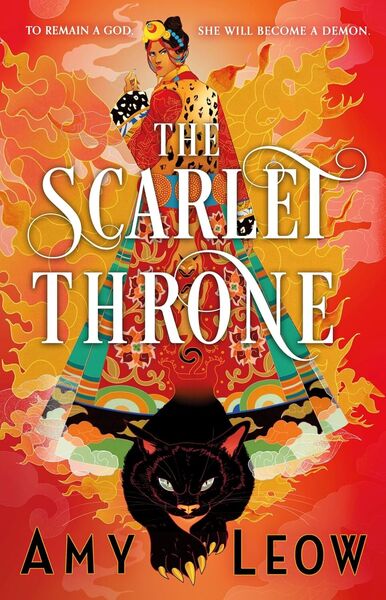Darling Daughter
The Scarlet Throne (False Goddess, volume 1)
By Amy Leow

27 Dec, 2024
2024’s The Scarlet Throne is the first volume of Amy Leow’s secondary-universe fantasy, the False Goddess Trilogy.
The goddess Rashmatun manifests to her devout followers by possessing the body of sanctified host girls. Through these living vessels, known as Rakhti, the goddess makes her will known. This system has functioned for centuries.
The current Rakhti is a teenager named Binsa. Binsa has secrets. For example, although traditionally Rakhti serve for a short term, Binsa has no intention of leaving office. For another example, Binsa is no holy vessel, just a barefaced liar dependent on demonic magic.
Binsa did not set out to be a false vessel. Her mother Kavita was the architect of that plan. A dark sorceress, Kavita cheerfully embraced blood magic, mental manipulation, and murder to make Binsa the next Rakhti. Kavita’s scheme worked perfectly, except for the part where Binsa, tiring of being her mother’s puppet, murdered her mom.
Binsa has no desire to stop being the Rakhti. Tradition says that each Rakhti serves for a few years, enjoying enormous status and power, leaves office with just enough money for a dowry, after which they are expected to marry, have children, and live lives of utter obscurity. No contact is allowed between former and current Rakhti. In fact, the former Rakhti are allowed no contact with temple staff at all, a detail that is in no way suspicious.
Being reduced from avatar to meek housewife does not appeal to Binsa. She has decided to break the system and remain the Rakhti. To this end she has partnered with a demon, Ilam, has learned the rudiments of blood magic, and has developed a talent for barefaced lies backed by improvisation.
Fate does not smile on Binsa. A drought plagues the land. For some reason, goats keep falling out of the sky and killing people. The logical person to blame is the current vessel. Binsa is displeased to discover that the search for the next Rakhti is already under way.
The candidates are whittled down to one virtuous girl, Medha. To her annoyance, Binsa likes Medha. Nevertheless, Binsa is relentless. She deepens her pact with her demonic mentor. With human sacrifice-fueled magic on her side, she cannot lose!
There are at least three flaws with the plan:
- The priests are just as determined to hold onto power as is Binsa; they have secrets that Binsa only belatedly begins to suspect exist.
- The cost of blood magic is greater than she knows.
- Medha’s sister was one of the girls Kavita murdered to secure Binsa her position. Medha is determined to find and expose the murderer (or murderers).
Will Binsa be forced from office or exposed as a villain? Even if her evil scheme succeeds, is she willing to pay the price?
Readers unfamiliar with Leow’s source material will be happy to know there are author notes at the end of this volume.
While clearly part of a series, this novel stands on its own. That’s a model more series fantasy should heed. I’d wonder how the author would handle inclueing readers in later volumes, but as she starts the narrative once it is well under way, I expect the answer will be “as effectively as she did in this volume.”
I think at this point in the history of speculative fiction, it would be more surprising if it turned out that the invented religion in this book were true and properly documented, rather being revealed as misinterpreted, partly forgotten, or an outright fraud. If secondary-universe characters had been reading SFF, they would suspect that there’s something shady about their gods and if not their gods, then the priests.
If I ever do a list of characters ill-suited to be teachers, Ilam deserves a spot. In his defense, he is a demon.
The novel is told from Binsa’s perspective. The reader gets a very clear view of why Binsa feels she is justified in subverting her nation’s religion and participating in enough murders to impress the Countess Bathory. In fact, the case for holding on to office is stronger than she suspects, as her attempt to contact her predecessor reveals.
Since she didn’t start the scheme (her mother did), we could see her as a survivor trying to make the best of a bad hand, having been actively denied vital, need-to-know information. Binsa needs to avoid, for example, failing Wish 101. Too bad for Binsa, but entertaining for readers.
Given the carnage Binsa leaves behind her, and the speed with which she makes morally questionable choices, it’s just possible some readers may see her not as an essentially sympathetic person who made some lamentable decisions and more of a grand villain in training. Well, everyone should have career goals; aspiring to epic villainy is definitely a goal worthy of a series.
The Scarlet Throne is available here (Amazon US), here (Amazon Canada), here (Amazon UK), here (Apple Books), here (Barnes & Noble), here (Chapters-Indigo), and here (Words Worth Books).
